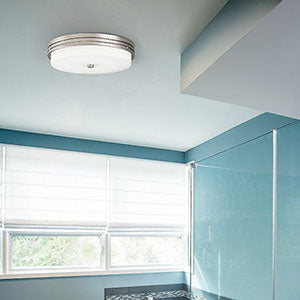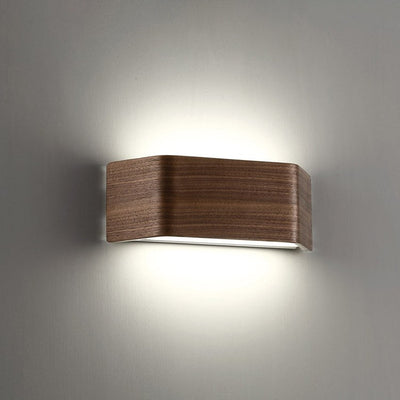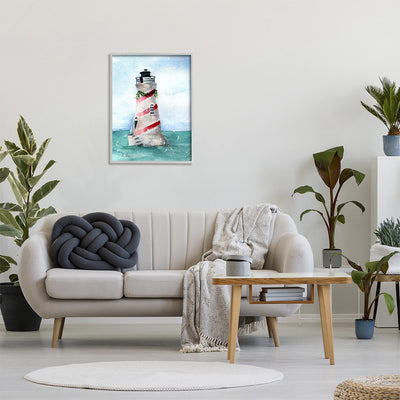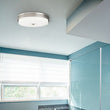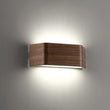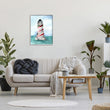Lighting
How to Brighten a Dark Room with Little (or No) Natural Light

Every room in your home needs love in the form of light—but perhaps none more so than windowless or low-light rooms. Bathrooms with no windows. Interior home offices. Basement rec rooms with well windows. No matter the time of day, these spaces are dim or completely dark without light fixtures. Read on for lighting strategies, design tips, and décor ideas that flip the switch on gloom and bring cheer to these rooms.
Give Every Room a 'Brightness' Walkthrough
There's probably more than one room in your home that could use brightening. Make sure to go through your entire house during the day to identify which areas need more light. Some may surprise you; others are more common:
Guest bathrooms and half-baths. Some have small windows, but many don't have windows at all. Others may have a transom window that delivers a hint of natural light from an adjoining room. Even some master baths have low light, such as in apartment buildings and condos with neighboring buildings that block the sun.
Walk-in closets and pantries. More often than not, these rooms are windowless.
Finished basements. Many basements feature well windows—small windows near the ceiling set within reinforced wells in your front, side, or backyard. These windows don't provide much light.
Bedrooms and kitchens. Chances are you think of sun-filled rooms when you think of these spaces. Though these rooms likely have at least one window, sometimes they don't get much natural light. Some possible reasons include:
- The windows have a north-facing position, which typically gets the lowest light.
- There's a tree close to the window. Though lovely, evergreens will block sunlight year-round, and deciduous trees can block sunlight in the spring and summer.
- Your neighbors are nearby. If the adjacent house or condo sits very close by, it could cast a shadow for much of the daylight hours.
How Do You Increase Light in a Dark Room?
Beyond windows, two other elements contribute to a room's brightness: décor and lighting.

Repaint the room a light, sunny color. Light grey. Lemon yellow. Light purple. Robin's egg blue. These are all colors that bring the light.
Decorate for Brightness
Dark walls, floors, and accent rugs absorb light, which serves to make no- or low-light rooms even darker. Furniture with upholstery in dark hues or with dark wood stains has the same effect. You may not be able to change everything, but you can refresh and brighten any space. Here are ideas to consider:
Repaint the room a light, sunny color. Light grey. Lemon yellow. Light purple. Robin's egg blue. These are all colors that bring the light.
Add light-wood or white furniture or fixtures. Depending on the purpose of the room, choose chests and cabinets, shelves, or desks in light hues to brighten the space.
Include mirrors and reflective decor. Metallic accents and mirrors amplify the existing light in a room (whether it comes from a well window or a desk lamp) and bounce light around the room.
Choose bright wall art. You may love that dark and moody painting, but a low-light room isn't the ideal location for this masterpiece. Instead, relocate your favorite dark artwork to bright rooms and add bright and light-colored wall art to low-light spaces.
Position large furnishings perpendicular to the window. This cuts down on the amount of light absorbed by large dark-finished bookshelves or couches with dark upholstery.

Position large furnishings perpendicular to the window.
Match Light Fixtures to Room Size and Use
Of course, adding lights to a dark room will brighten things up. But different spaces call for different light fixture types and placement decisions.
- Use inconspicuous overhead fixtures such as recessed or flush mount lights, directional ceiling lights, and linear lighting in rooms with low ceilings and tight spaces.
- Deliver light—and a little something extra—with ceiling fan lights or chandeliers. A ceiling fan makes small rooms less stuffy, and a well-chosen chandelier reflects light with crystals or reflective metal elements.
- Hang pendants in a walk-in closet or pantry to add brightness and an appealing focal point, while allowing you to move around with ease.
- For very constricted spaces, opt for light or mirrored sconces. Wall fixtures don't take up prime floor, ceiling, or desk space, while adding plenty of light and style.
- Use table or floor lamps in addition to ceiling lights in dark or dim guest rooms. Depending on the number of visitors, this gives you the flexibility to add side tables or make room for another bed, if needed.
More Strategies to Make Low-Light and Windowless Rooms Brighter
Light in Layers
You need ambient and task lighting, plus lighting for beauty's sake. Layered lighting ensures you hit all of these marks. Start with a ceiling light (flush, recessed, or track lights), and then focus on head-height or eye-level lights (floor lamps, sconces, pendants, and chandeliers). Finally, add mid-level lights for tasks and reading (side table lamps and undercabinet lights). You may not need all three levels in smaller rooms, but having at least two fixture variations will balance the light.

Bump up ambient light with upward facing bulbs that reflect off low ceilings
Focus on Bulb Brightness
Many people are swapping out their halogen and incandescent light bulbs with LEDs. They're more energy-efficient, cooler to the touch, and last longer. Even better, they come in varied styles, many even mimicking the traditional (and ever-popular) Edison-style light bulb.
Whichever style bulbs you choose for low-light rooms, it's important to understand the differences.
LED vs. incandescent: LEDs use 5 times less energy and last 25 times longer, but they aren't available in higher wattages. If you're replacing incandescent bulbs with LEDs, you may need more LED lights to achieve the same effect.
LED vs. halogen: A 6 or 7 watt LED bulb is close to a 50-watt halogen bulb but doesn't put off anything close to the same amount of heat. Halogen bulbs produce a white color temperature like LEDs.
Incandescent vs. halogen: Halogen bulbs are more efficient than incandescent bulbs. They burn a little brighter than incandescents (closer to actual sunlight) but put out more heat.

Choose fixtures with light-colored metallics to help spread the light around.
Choose Bright Finishes and Lamp Shades
Light fixtures are part of any room's décor, contributing to its style and beauty. Here's how to make sure your light fixtures brighten dim spaces:
Maximize brightness with metallics and reflective elements. Choose fixtures with light-colored metallics to help spread the light around. Think brushed nickel and stainless steel, gold, and chrome. There are even fixtures with in-laid mirrors for maximum brightness.
Lighten things up with white, cream, and other light-hued colors. You'll often find these light colors in rustic and farmhouse-style light fixtures. Opt for white and cream shades.
Add a dash of color. Vibrant yellow. Sky blue. Bright red. Pendants in bold colors add brightness and style.
Wash One Room Wall In Light
Use recessed lights, wall sconces, directional ceiling fixtures to illuminate a light-colored wall. This can cast light on a piece of artwork, or simply brighten the entire space.
Adjust Light Levels
Timers and dimmers help adjust light levels in interior hallways and your home office, so you have lighting at the brightness you need and don't waste energy.
Lighting Ideas for Various Dim and Dark Rooms
Now that you have lighting strategies, explore quick lighting design tips that bring a splash of brightness where needed most.
How to Brighten a Small, Dark Bathroom
Mix linear vanity lighting, such as a rustic bare bulb fixture, with a coordinating flush-mount light showcasing bare bulbs beneath a seeded glass shade. If you have a little more space explore our guide to vanity lighting for style and fixture combination
How to Brighten a Walk-in Closet
Use directional recessed lighting (such as eyeball fixtures) to shine light on every side of the closet. Or, combine a beautiful mini-crystal chandelier with recessed lighting over the full-length mirror. You can also add under-cabinet lights to open shelving if there is a decorative rim to hide the fixture.

How to Brighten a Pantry
Don't settle for a boring rectangular ceiling fixture. Instead, opt for a stylish flush or semi-flush fixture . For pantries with low ceilings, choose recessed lights with visible trim in reflective chrome.
How to Brighten a Low-Light Kitchen
Kitchens in any shape (galley, U, L, or corridor style) can suffer from low light if there's only one window. Choose designer pendants or a bold chandelier to deliver ambient and task lighting (plus a "wow" element) to a kitchen island or breakfast nook. Add under-cabinet lighting to brighten countertops without taking up space. Finally, strategically placed recessed fixtures provide fill lighting throughout the kitchen.
How to Brighten a Finished Basement
Feature a low-profile ceiling fan to add welcome air circulation and brightness to your basement, whether it's a game room, television room, or storage space. Torchieres help bump up ambient light with upward facing bulbs that reflect off low ceilings. Add white or light metallic table lamps next to the couch, plus recessed lights over a pool table or exercise corner.
How to Brighten Dark Halls and Stairways
Depending on the clearance, semi-flush mount fixtures or chandeliers are bright options for the top of a stairway or above a landing mid-flight. Choose a style that matches your overall interior design, because these fixtures draw attention and bring together two floors in your home. Decorative wall sconces and recessed lights chase shadows from the section of hallway furthest from the window.

How to Brighten a Dark Bedroom
Provide ambient light with a chandelier or ceiling fan , and task lighting with bedside lamps or sconces. Pay attention to bulb color temperatures—bright lights (5000K) in ceiling lights for wakeful mornings, and soft, warm lights (2700K) in bedside lamps to prepare for sleep.
You want every room in your house to provide a warm welcome. Use these tips to make sure every square foot is bright enough for work, rest, or play.

